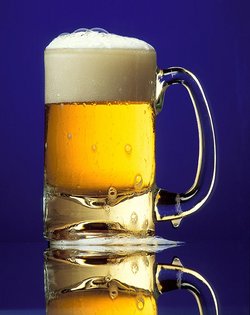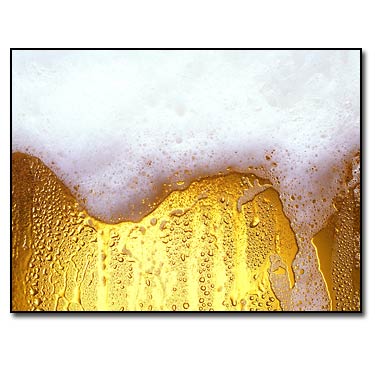Dressed In Lace
At the inaugural “Drink With The Wench,” I distributed Beer Tasting and Rating Sheets from Ratebeer.com to everyone interested in playing along with me. The sheet breaks down the tasting experience into four major categories; Appearance, Aroma, Palate, and Taste. Each category is further broken down, prompting the taster with adjectives to identify and circle.
The Appearance category is broken down into head, lacing, body, particles, and color. Everyone understood most of the subcategories, except for lacing. For the most part, the adjectives listed next to each subcategory gave the taster a clear idea of what they should be seeing and rating. Lacing, on the other hand, was to be ranked as excellent, good, fair, and spare — which tells the taster nothing about what it is.
And so, naturally, everyone asked me what lacing meant. Luckily, I actually knew what it was — yet, I had no idea what its relevance was to beer. Now I know, and so I will enlighten those who may not know.
Before explaining lacing, I must first talk about beer foam. Foam is among one of the most hotly debated topics in today’s beer drinking society. Doctoral dissertations and even whole careers have been based upon the study of beer foam.

Most brewers desire foam with optimum stability and quantity. The most commonly used method for evaluating beer foam quality is the Rudin head retention test (HRV). The NIBEM is essentially the most common measure for beer foam stability.
Beer has been around for thousands of years but, as most historians agree, beer foam has not been. In the past, beer would spoil soon after it was made, allowing the gas in beer to escape. As beer production methods improved, so did techniques to help retain carbonation.
Carbon dioxide is the source of carbonation in beer. How does it get there? Carbon dioxide is a natural byproduct of the fermentation process. The equation is rather simple. Every type of alcohol is made with both yeast and sugar. During fermentation, yeast eats the sugar. In the absence of oxygen, the yeast converts that sugar into ethanol and carbon dioxide. Ethanol is simply beverage alcohol. (Having said this, one can easily deduct that more sugar + more yeast = more alcohol. But more on that another time.)
Now the real question is, if CO2 is the byproduct of every alcoholic beverage, why are some drinks sparkling while others are flat? Essentially, beer ferments extremely rapidly –usually in a week or less. Most of the CO2 produced during fermentation escapes from the beer, however, the fully fermented product still contains a lot of dissolved CO2. Wine and saké ferment more slowly, allowing virtually all the gas to escape before completion.
Since the majority of gas escapes, most fermented beer requires an additional dose of carbonation before it is packaged. This is usually done in one of two different ways. The modern method is to put beer in a closed pressure tank and pump carbon dioxide in. Brewers can follow a traditional method instead, by adding unfermented beer -called wort- along with some yeast. The yeast ferments the wort to produce additional CO2, which will dissolve in the beer.
At the Brauhaus, keg beer is usually stored in a cooler that is some distance from the tap where it is served. Typically, carbon dioxide is applied to the top of the keg. A line to the tap is drawn from the bottom of the keg. Anytime the tap is opened, gas pressure drives beer out of the keg, through the line and into the glass.

In the glass, some of the CO2 comes out of solution to form bubbles. As the bubbles rise to the top of the glass, they combine with other bubbles and increase in size. At the top of the glass, all the bubbles gather into frothy foam.
Complex, surface-loving organic compounds determine the strength and longevity of beer foam. Each bubble consists of an organic coating with CO2 trapped inside. Bubbles burst when the coating is not strong enough to contain the gas.
Another factor that contributes to a stable head is alcoholic strength. Remember the formula? The higher alcohol comes from increased quantities of sugar (aka malt), so the more malt a beer has – the more alcohol and CO2 it has as a byproduct. Beers that are higher in malt typically have larger heads. Foam is also a good indication of hops. Light beers with low hop levels have very little foam.
A good head of foam will typically deposit a generous, lacy “cling” on the glass. Lacing refers to the lacy white ring that usually remains on the glass after the head dissipates.
Most novice beer drinkers do not enjoy foam interrupting their drinking experience. In fact, many people feel foam just occupies space in their glass that could be filled with beer.
Many professionals and brewers may argue that beer foam is essential to the tasting experience. Beer foam affects the mouth feel of beer and increases the creamy sensation of beer when consumed.
Beware head lovers, oil kills foam. Glassware that has not been properly cleaned and rinsed can significantly impact the amount and duration of head and lace. Hence, the old nose grease trick to reduce the level of foam.
I hope this helps all who were stumped by the significance of head and lace appearance.















Ballast Point Brewing Co. Sea Monster Imperial Stout « Basicallyred – To Be Read, Basically March 17th, 2010 at 7:51 am
[...] shade of pancake batter. If the pour itself didn’t show me how viscous this liquid is, the lacing on Sea Monster is reminiscent of whip cream remnants at the top of a milkshake glass, which in turn [...]